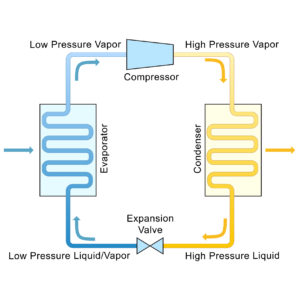 The best way to maintain or repair any mechanical system is to start with an understanding of how it works. Once you know how a system works, it can be easy to anticipate its need for maintenance and if it malfunctions, you can often reason your way to why the problem happened and get it fixed easily. In this article, we’ll talk through how AC works in your car so you can keep up with regular maintenance and any necessary repairs.
The best way to maintain or repair any mechanical system is to start with an understanding of how it works. Once you know how a system works, it can be easy to anticipate its need for maintenance and if it malfunctions, you can often reason your way to why the problem happened and get it fixed easily. In this article, we’ll talk through how AC works in your car so you can keep up with regular maintenance and any necessary repairs.
To understand how AC works you need to start with one simple principle. This principle is used in all cooling devices that work off the refrigerant cycle, and it is the reality that when a gas is compressed it absorbs heat and when it is allowed to expand it will cool down. This basic principle is what runs the heat pump in your house, your refrigerator’s cooling system, and the air conditioner in your car.
In the world we live in you cannot create or destroy energy, like heat, you can only transform it or transfer it. The goal of the air conditioning system in your car is to simply transfer the heat energy from inside your car to the air outside of your car. This heat energy is transferred out of your car in the refrigerant in your air conditioning system. The refrigerant starts its journey in the evaporator in the cabin of your car. There, the refrigerant absorbs heat from the cabin of your car from the air that the blower in your ventilation system blows over the evaporator. Once the refrigerant has absorbed the heat from your car it is sucked into the compressor in your air conditioning system. In the compressor, the warm low pressure refrigerant is compressed. Since compressing a fluid adds heat to it, the refrigerant comes out of the compressor at a higher pressure, but also a higher temperature.
From the compressor, your refrigerant travels to the condenser at the front of your vehicle. Here, all the heat the refrigerant absorbed from your vehicle’s cabin and the compressor is transferred to the outside air. The refrigerant leaves the compressor at the temperature of the air outside your car, but still at a high pressure. Next, the refrigerant travels to an expansion valve or orifice tube. Both devices accomplish the same goal of quickly reducing the refrigerant pressure which consequently lowers the temperature bellow both ambient temperature and the temperature of the air in the cabin of your vehicle.
The last leg of the journey for the refrigerant is to travel back to the evaporator where it can absorb heat from the air in the cabin of your vehicle.
One of the main factors that allow this process to happen correctly are the temperatures and pressure that are present in the system. Refrigerants, like R-134a that is most likely used in your vehicle, are compounds manufactured to work perfectly in a refrigeration cycle at certain temperatures and pressures. Since we don’t have any control over the temperature inside the cabin of your vehicle or outside your car, the pressures are what are closely controlled in an air conditioning system. Of these pressures get outside of a certain range, the system will quickly start to malfunction.
The low pressure in your air conditioning system is dictated mostly by the amount of refrigerant that is in the system. Too much refrigerant and the pressure gets too high and vice versa. The high side pressures in your system are controlled by the compressor and how it was designed and how well it’s functioning. If you find your air conditioning system malfunctioning the best place to start looking for answers is in the pressures in your system. Low pressures can indicate a lack of refrigerant or a malfunctioning compressor while high pressures can indicate an overfill or a clog somewhere in your system.
If you suspect your system is low on refrigerant, make sure you seal the leak before you add any more refrigerant to keep you from simply wasting money on more refrigerant. To seal the leak in your system, add Red Angel A/C Stop Leak either from our convenient aerosol can or with our liquid formula through the Red Angel Oil Injector.
You can find all these Red Angel products at any of our partnering local auto parts stores like:
- AutoZone
- Advance Auto Parts
- Bennett Auto Supply
- CarQuest Auto parts
- NAPA Auto Parts
- O’Reilly Auto Parts
- Pep Boys
- Fast Track
- Bumper to Bumper Auto Parts Specialists
- S&E Quick Lube Distributer
- DYK Automotive
- Fisher Auto Parts stores
- Auto Plus Auto Parts stores
- Hovis Auto & Truck Supply stores
- Salvo Auto Parts
- Advantage Auto Stores
- Genuine Auto Parts stores
- Bond Auto Parts stores
- Tidewater Fleet Supply
- Bumper to Bumper Auto Parts
- Any Part Auto Parts
- Consumer Auto Parts
Pictures Provided By:
how_AC_works.jpg – By mrhighsky – Licensed by Getty Images – Orginal Link